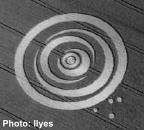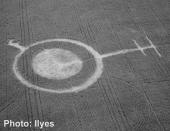BLT RESEARCH TEAM INC.
Cambridge, MA (USA)
[www.bltresearch.com] ` BLT Research Report #0501
__ VINJE, SNASA, NORWAY - December 11, 2003 __
A 14m-long “ice-pictogram” w/double rings; design formed by ice 2-3 cm high which stood out in “relief” on a field of grass when snow fell and covered ice. Videocamera batteries failed when
witnesses tried to film closer to pictogram than photo below.
Ice "Pictogram"
VINJE, SNASA, NORWAY – 2003
File Code: BLT #0501
Date of BLT Report: May, 2005
Event Location: Field near Vinje, Snasa, Norway
Date Discovered: December 11, 2003
Date Sampled: May 12, 2004
Material Sampled: Soil
Sampled By: Mr. Anders Mona, for The Norwegian Crop Circle Group
Event Description: A 14m overall length, double-ring design with intersecting right-angled pathways, one of which extends West/Southwest beyond circular pattern. Rings and pathways created by ice deposits on top of grass which were approximately 30 cm. wide by 2-3 cm high (see Figs. 1-3).
Sampling Details: Four soil samples were taken from the ice rings and pathway locations, many of which were still visible due, at sampling, to the absence of grasses in these areas (see Fig. 4). Four controls were also taken, 20m - 40m distant (see Fig. 5 – "Sampling Diagram").
Laboratory Analysis: Infrared spectroscopy conducted on soil samples and controls in the "as received" condition, and on solvents extracted from these soils, by Phyllis Budinger, Analytical Chemist, Frontier Analysis, Ltd – Chagrin Falls, Ohio(See full report, attached)
Results:
1. No extraneous chemical contaminant was detected in the sample soils from the ice-pictogram, as compared to the control soils;
2. Ammonium nitrate (a common fertilizer) was detected in similar amounts in both the pictogram samples and the controls, as well as other natural soil organics.
Discussion: Because the "ice-pictogram" design was formed by a layer of ice on top of the field, and because there is no known structure beneath the surface nor any evidence of a structure on top of the field, the question was raised as to whether
a chemical of some sort had been applied topically which caused the ice to form in this design?
Since the infrared spectra of both the control and sample soils are identical
(and neither show extraneous chemical contaminants), and since only remnants of ammonium nitrate (fertilizer) and other natural soil organics were found in any of the samples, the hypothesis that a topically-applied chemical was responsible for the creation of the design seems highly unlikely. Based on our current data we cannot determine causation.
Fig. 1: School-children (top) who discovered ice-pictogram pointing to area (now covered with snow but w/pattern drawn-in on photo) where pattern was found on 12/11/03. Bottom photo shows pattern later on, when snow-cover had melted a bit.
Fig. 2: Ice-pictogram two months later, on February 21, 2004. The ice-rings and pathways which form the design are approximately 30 cm in width. Photos: Thor Riseth.
Fig. 3: Close-up of one ice ring (approx. 30 cm wide), photographed in February, 2004; note color alteration in grasses where ice-ring has melted. Photo: Thor Riseth.
Fig. 4: Anders Mona and associate taking soil samples in May, 2004 for chemical analyses; some of the rings and pathways of the ice-pictogram were still visible (due at this time in May to the absence of grasses in these areas), making sampling relatively easy.
Fig. 5:

| 




